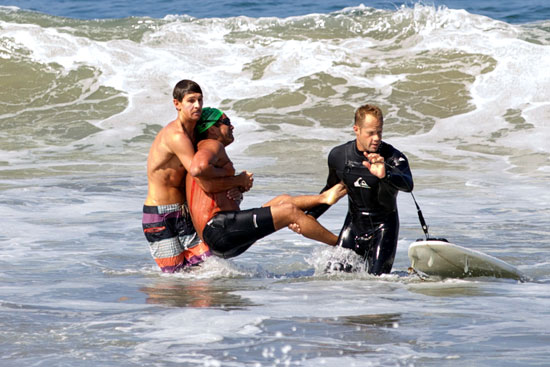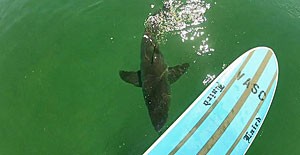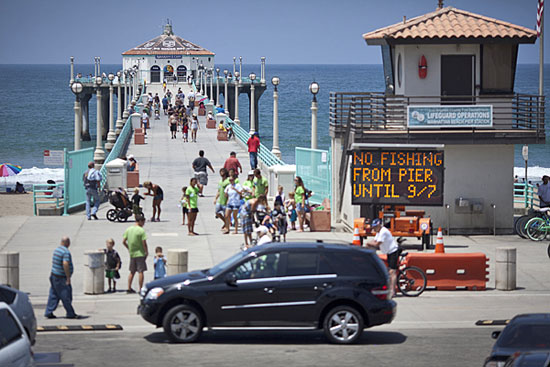Shark bite opens debate
July 10, 2014

Steve Robles is pulled from the Manhattan Beach surf after his encounter with a snagged white shark.
The fisherman is off the hook. But his headline-grabbing behavior on the Manhattan Beach pier—when he snagged a young great white shark that thrashed and ended up biting a swimmer—is still churning up debate over how best to protect the beach-going public.
Manhattan Beach has quickly moved to ban all fishing from the pier for up to 60 days, although the California Department of Fish and Wildlife is weighing whether the city may have overstepped its authority on the state-owned pier. Meanwhile, Los Angeles County lifeguard officials have begun refining a new policy to create buffer zones between swimmers, surfers and the young sharks that increasingly are making Manhattan Beach their home before they head to deeper waters.
What’s more, officials now are being forced to confront an undercurrent of hostility that for years has strained relationships around the 94-year-old concrete pier, the oldest in California.
The sensational incident during the July 4th weekend—mistakenly characterized in early news reports as a shark attack—has exposed long-running complaints by surfers and swimmers that some pier fishermen have been endangering them. Among other things, they accuse fishermen of illegally “chumming”—dumping buckets of fish guts off the pier—to attract sharks.
“Tempers have been flaring,” said Los Angeles County Lifeguard Captain Kyle Daniels, who’s stationed in Manhattan Beach. “We do our best to separate the groups but it’s a dynamic situation. This goes back years.”
The Saturday incident brought it all to the surface, generating a wave of national news coverage and social media finger-pointing—most of it aimed at the fisherman and his friends, who were bombarded with allegations of animal cruelty and human indifference. The group was caught on video laughing and joking in the moments before they realized that a swimmer had been hurt by the distressed shark on the end of their high-gauge line. As of Thursday, the video had more than 1.4 million views.
According to witnesses, fisherman Jason Hagermann had been battling with the 7-footer for 45 minutes. The fish surfaced just as a group of distance swimmers passed while training for an upcoming pier-to-pier event. The victim, Steve Robles, can be heard on the video wailing as other swimmers rush to his rescue. Robles, a former L.A. County lifeguard himself, suffered serious but non-lethal gashes under his arm and along his side.

Juvenile great whites have been feeding in Manhattan Beach "like infants at an all-you-can-eat buffet."
Under state and federal law, it’s illegal to target great whites. If one gets hooked, then the line must be promptly cut. Hagermann told Fish and Wildlife investigators that he hadn’t been fishing for great whites and that he was afraid to cut the line while so many swimmers were nearby. With no evidence to contradict him, an agency spokeswoman said, no charges were filed.
Still, county lifeguard Daniels and others familiar with shark behavior insist the fish would never have bitten anyone had it not been fighting for its life. “If you lassoed and dragged a bear through a crowd,” he said, “I’m sure someone would get hurt.”
Daniels also said that the exceptionally strong wire-like line the fisherman was using posed a far greater danger to public safety than the juvenile shark. Had the fish quickly darted across and underneath the group of swimmers, “the line would have cut through to the bone.”
Laurie Jester, acting director of community development for Manhattan Beach, said the 60-day ban on pier fishing will give officials an opportunity to determine whether new restrictions should be imposed to avert these kinds of preventable risks.
“There’s a public safety concern with fishing on the pier,” she said, “and we want to make sure we’re covering all our bases, consulting with all the right people.”
The Los Angeles County Fire Department, which oversees lifeguard operations, has also moved in recent weeks to protect swimmers and surfers from potential harm.
Chief Daryl Osby said the department introduced a policy this summer to create “exclusionary zones” 300 yards into the water when sharks bigger than 8 feet are spotted because, unlike juveniles, these animals “can sometimes exhibit aggressive behavior, representing a public threat.” Osby said the department, in consultation with scientists at the Monterey Bay Aquarium, has developed a public education program “so beachgoers can become aware of the environment and habitat they’re about to enter.”
That habitat, scientists and others say, is increasingly a shared one, as rising numbers of young white sharks are taking up temporary residence at the popular El Porto surfing area, at Manhattan Beach’s northern end.
As a result, “the curious and the YouTube seekers” are boarding all sorts of crafts for a view of the sharks as they feast on the bay’s plentiful offerings, “like infants at an all-you-can-eat buffet,” said Manhattan Beach’s ex-mayor, Steve Napolitano, now a senior aide to Los Angeles County Supervisor Don Knabe, whose district includes the South Bay.
International big-wave rider Alex Gray, who’s also an avid fisherman, has been playing in the Manhattan Beach surf since he was a kid. He resents the human intrusions into the young white sharks’ habitat.
“Give the animals the respect they deserve and allow them to be at home,” he said the other day, as he looked out across the Pacific. “What if I walked into your house, took a picture of your family eating dinner and then walked out? Give respect, get respect. Just let them be.”
“I’ve traveled the world and I’ve never once had a bad encounter with a shark,” he added. “If I see a shark, I give it its area. I would never paddle up to it for a picture.”
Gray, 28, said the one thing that “breaks my heart” about the Manhattan Beach incident is that “kids might now be afraid to go into the ocean…I love this community more than anything. It hurts me when I see negativity that doesn’t need to be there.”
Posted 7/10/14













 405 bridge work causes a stink
405 bridge work causes a stink
